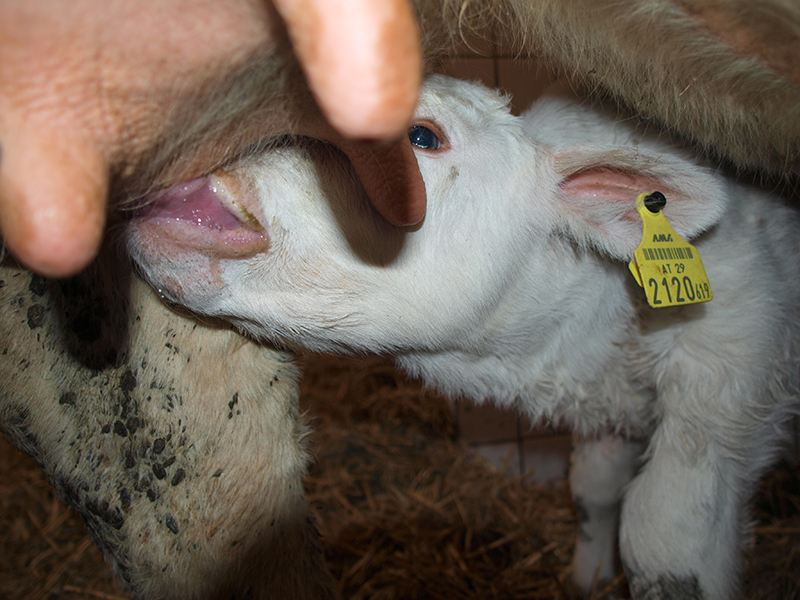In Austria, suckler cow farming has become increasingly important as an extensive form of cattle farming in recent decades, especially in mountain areas and predominantly on part-time farms. It makes a significant contribution to keeping the cultural landscape open in these areas. In addition, meat production in suckler cow farming corresponds to a large extent to consumers' increasing expectations regarding natural and animal-friendly food production. In suckler cow farming - especially after the abolition of the "sucker cow premium" - the raised calves represent the main source of income and are therefore crucial for the economic viability of the system. The aim must be to be able to wean a vital, well-developed calf from the mother cow every year that has good weight gain and excellent fattening properties. The cow's milk production plays a central role. The more milk the calf has available, the faster it can grow.
However, suckler cows are often kept on particularly extensively managed areas (extensive grassland in mountain areas on alpine pastures and high alpine pastures or nature conservation areas). However, feed quality has a crucial influence on feed and nutrient intake and thus body condition. Under- and over-supply not only affects milk production and thus calf development, but above all also on animal health and fertility. A moderate basic feed quality leads to a significant and long-lasting nutrient deficiency in suckler cows during the nursing period and a corresponding decrease in body condition. However, the body condition at calving has the greatest influence on a new cycle or a new pregnancy. Only if the weaning date is adapted to the feed quality (the poorer the feed, the earlier) can the body reserves be replenished until the new calving, so that no negative influence on animal health and fertility is caused.
The effects of different weaning dates (180 or 270 days) on extensively fed Simmental cows was the focus of a research project at the Higher Federal Teaching and Research Institute Raumberg-Gumpenstein.
How and what was investigated
The focus of this work was on the effects of the weaning date on milk production, feed intake and nutrient supply, live mass development as well as animal health and fertility. The cows were fed exclusively with late-harvested basic feed. The experiment extended over 3 complete suckling and 2 dry periods. In addition to daily feed intake, both milk production and body weight of the cows were recorded once a week. In addition, the animals' body condition was assessed once a month. All observations and treatments were noted and the care of the animals was checked by taking blood samples and determining the most important blood parameters. The experimental data was evaluated as part of a master's thesis at the University of Natural Resources and Life Sciences (HÖRMANN, 2013).
Results
The average lactation performance was 2,250 kg (2,053 kg ECM = energy-corrected milk) with a nursing period of 180 days and 3,270 kg (2,858 kg ECM) with a nursing period of 270 days. This difference was significant due to the different duration of lactation. The average daily milk quantities were 12.4 kg and 11.9 kg milk and the fat and protein contents were 3.45% and 3.16% and 3.10% and 3.03%, respectively.
During the nursing period, the cows consumed an average of 13.7 kg and 14.4 kg per day and in the dry period 13.3 kg and 12.9 kg of dry matter (DM) per day. As the number of lactations increased, the daily feed intake increased significantly from 13.5 kg to 13.8 kg to 14.9 kg DM. The amounts of feed consumed during the calving interval also differed significantly between the two groups.
Group 2 suckler cows had lower live weights and body condition scores in the second lactation. This led to significantly deteriorated fertility data and an extended calving interval, which increased feed requirements.
Conclusions and recommendations
• The milk production of Simmental cows is at a high level compared to other suckler cow breeds. This has advantages for the calf's development, but on the other hand, it increases the demands on the ration, especially during the suckling period.
• Milk production is satisfactory even with moderate forage quality, although lower milk ingredient levels can occur and this can have negative effects on fertility.
• Especially in the first months of the nursing period, the cows should receive good quality basic feed so that they produce high milk yields with good milk ingredients, do not lose too much body substance and become pregnant again quickly.
• In order to meet the different requirements regarding nutrient intake and energy density, there must at least be a separation between lactating and dry cows.
• To assess the feeding or housing conditions, an assessment of body condition (BCS) or weighing of the animals must be carried out regularly.
• Obesity in suckler cows can cause complications during birth and leads to higher milk production at the beginning of the nursing period, which in turn leads to increased body fat mobilization and thus to greater metabolic stress. Both of these in turn have a negative effect on fertility.
• Too low body condition at the time of calving leads to lower ECM performance (lower milk components) and, like obesity, has a negative effect on fertility and thus the calving interval.
• The weaning date must be adjusted to the quality of the forage. The poorer the feed quality and the less feed available, the sooner the calves have to be separated from the cows.







